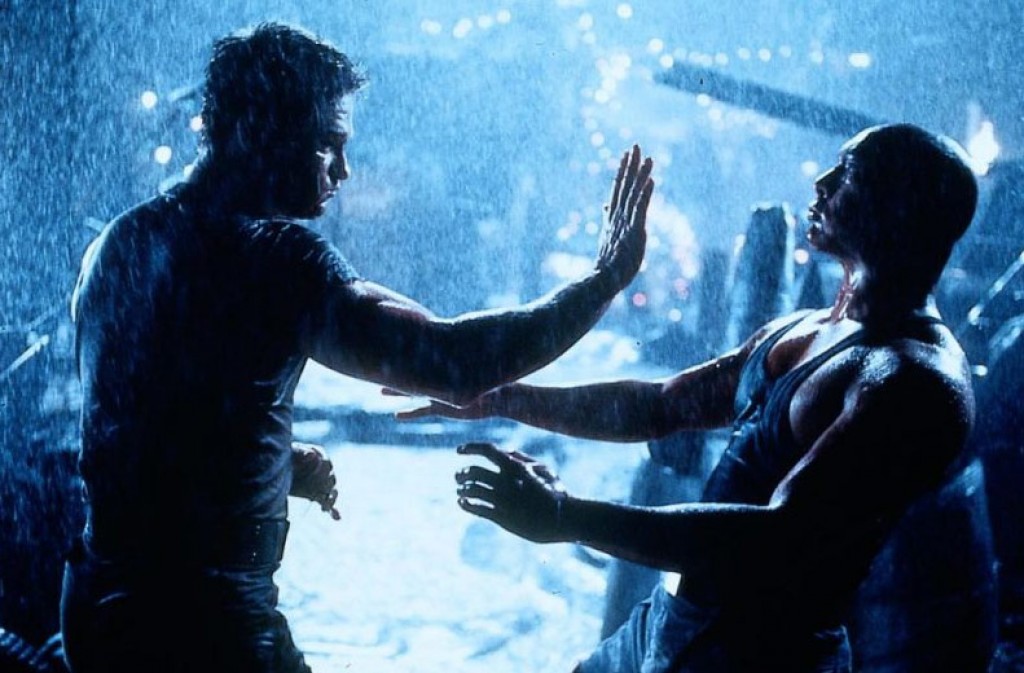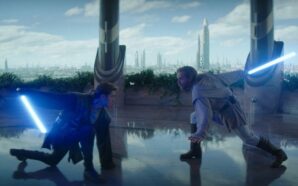The imaginatively named sci-fi action film Soldier was released in October of 1998 and upon first glance it’s a film that should be forgotten. It’s not particularly good, it was plagued with production trouble including the star Kurt Russell breaking his ankle by tripping over an ornamental cabbage (no really) and it was a box office bomb, recouping only $14.6 million on a production budget of $60 million, $20 million of which was Kurt Russell’s salary alone. Directed by Paul W.S Anderson and released just 1 year after his previous sci-fi failure Event Horizon, a film simmering with potential while never quite reaching boiling point, Soldier could have been just one of those late 90’s action movies that felt outdated before they even reached movie theaters in an environment just waiting for The Matrix to come along and shake up the genre. But it’s not. Soldier hides a secret that has kept the film relevant and a cult classic since its release: it’s a sequel to Blade Runner.
 Okay, sequel might be the wrong term. David Webb Peoples, the co-writer of Blade Runner and writer of Soldier, considers the film to be a “side-quel” to the sci-fi classic, taking place in the same universe yet solar systems apart. Peoples wrote Soldier while Blade Runner was in production, with the film starting out as an unused opening for Blade Runner which would have seen Replicants on one of the frequently mentioned off-world colonies. Soldier ultimately follows Todd, portrayed by Kurt Russell, a soldier who was trained for nothing but violence and war since his birth. However, in the year 2035, Todd and his squadron are to be replaced by new, completely compliant super-soldiers that are bred rather than born (sound familiar?). Todd is cast aside and dumped on a junk-covered planet where he must find his humanity to fit in with, and protect, the community that lives there from the new soldiers. The new super soldiers are Replicants in every way but the most important: name. Without the rights to the world “Replicant”, can the film be seen as a Blade Runner sequel? Do the thoughts of the writer and director matter if what they believe is not shown onscreen? Well, it turns out the Blade Runner connections are not just the ramblings of David Peoples but there is actual evidence in the film.
Okay, sequel might be the wrong term. David Webb Peoples, the co-writer of Blade Runner and writer of Soldier, considers the film to be a “side-quel” to the sci-fi classic, taking place in the same universe yet solar systems apart. Peoples wrote Soldier while Blade Runner was in production, with the film starting out as an unused opening for Blade Runner which would have seen Replicants on one of the frequently mentioned off-world colonies. Soldier ultimately follows Todd, portrayed by Kurt Russell, a soldier who was trained for nothing but violence and war since his birth. However, in the year 2035, Todd and his squadron are to be replaced by new, completely compliant super-soldiers that are bred rather than born (sound familiar?). Todd is cast aside and dumped on a junk-covered planet where he must find his humanity to fit in with, and protect, the community that lives there from the new soldiers. The new super soldiers are Replicants in every way but the most important: name. Without the rights to the world “Replicant”, can the film be seen as a Blade Runner sequel? Do the thoughts of the writer and director matter if what they believe is not shown onscreen? Well, it turns out the Blade Runner connections are not just the ramblings of David Peoples but there is actual evidence in the film.
On the junk planet, a Spinner, the flying vehicle seen in Blade Runner, can be seen strewn among some wreckage. The trailer for the film, which is absolutely horrendous, uses the song “More human than human” by White Zombie, which is a quote from Blade Runner. Both said in the film and seen in a text document, it’s stated that Todd fought in battles at both “The Shoulder of Orion” and “Tannhauser Gate”. Both of these unique places are mentioned in the famous “tears in rain” speech from the end of Blade Runner and therefore implies a connection. Then again, the same document that mentions them also references several other sci-fi action franchises that Soldier is definitely not connected to, such as Star Trek, Escape From New York and Doom, so any connections implied here are probably just easter eggs and have to be taken with a grain of salt. Curiously, there is also mention of the Pulse Rifle and Smart-Gun from the 1986 film Aliens in the film which gives more credence to the popular fan theory that Blade Runner and the Alien franchise are actually set in the same universe, as I have previously written about here.
It’s not just in the details where connections between Soldier and Blade Runner can be made but thematically too. Blade Runner is about, among other things, what it means to be human. It’s why I interpret Deckard to NOT be a Replicant because I think the film is much stronger if, by the “tears in rain” speech at the end, Rutger Hauer’s Roy Batty, a Replicant, has become the film’s most human character while Harrison Ford’s Deckard, a human, has become the character acting the least human. Soldier is also about what it means to be human with Todd having to discover his humanity that had been stripped from him at birth. While previously he was robotic in his actions and would kill civilians as easily as armed combatants, now he has to fight to save such people from the new “Replicant” soldiers who remind him of who he used to be. The highlight of the film is Todd’s relationship with Nathan, a young mute boy he has to protect, whom he communicates with without speaking. Todd himself was “brainwashed” not to speak and does so very rarely throughout the film. The film ends with Tod and Nathan heading off together to an uncertain future, hunted by his former employers, much like the end of Blade Runner.
A film trying to weasel its way into the same category as a masterpiece like Blade Runner by mentioning as many pieces of information from the original film it legally can makes sense, trying to piggyback on an already invested fandom, but what isn’t expected is that last year’s Blade Runner 2049 seemed to go out of its way to embrace Soldier as part of the Blade Runner canon. There’s plenty of fresh new evidence to be found in 2049 that suggests Soldier is indeed in the same continuity, including that the almost apocalyptic event mentioned in 2049, “the Blackout”, occurred in 2022 and the community that Todd joins say they left Earth 12 years ago. Soldier takes place in 2035 which means they left Earth in 2023, just one year after “the Blackout” which would be a pretty good reason to leave. Is this shear coincidence or did one of 2049’s writers (probably Michael Green) retroactively add Soldier to the canon by fitting the Blade Runner timeline’s big events around information given in Soldier?
 The film and its events are actually included on the Blade Runner Wiki and timeline and fit perfectly. The “Soldier project”, that saw baby Todd get turned into a soldier, began in 1996 which makes sense because Replicants, who would usually take that role, were not created until 2005. Moving to 2035, the replacement soldiers are implied to be Replicants and in the Blade Runner short film “2036: Nexus Dawn” it’s implied that the Nexus-9 Replicants were developed in 2035. As discussed in 2049, the Nexus-9s are believed to be totally compliant which is the reason they are allowed to be reintroduced after “The Purge” and legally live on Earth for the first time. In Soldier, Colonel Mekum (the handler of the “Replicant” soldiers, played by Jason Issacs) states “We are doing such wonderful things with the mind”, possibly hinting at these new compliance directives. The timeline on the Blade Runner Wiki, which has to be taken with a grain of salt because it’s run by fans, does indeed state that Niander Wallace privately sends a group of Nexus-9 Replicants to Colonel Mekum as a trial before the official release.
The film and its events are actually included on the Blade Runner Wiki and timeline and fit perfectly. The “Soldier project”, that saw baby Todd get turned into a soldier, began in 1996 which makes sense because Replicants, who would usually take that role, were not created until 2005. Moving to 2035, the replacement soldiers are implied to be Replicants and in the Blade Runner short film “2036: Nexus Dawn” it’s implied that the Nexus-9 Replicants were developed in 2035. As discussed in 2049, the Nexus-9s are believed to be totally compliant which is the reason they are allowed to be reintroduced after “The Purge” and legally live on Earth for the first time. In Soldier, Colonel Mekum (the handler of the “Replicant” soldiers, played by Jason Issacs) states “We are doing such wonderful things with the mind”, possibly hinting at these new compliance directives. The timeline on the Blade Runner Wiki, which has to be taken with a grain of salt because it’s run by fans, does indeed state that Niander Wallace privately sends a group of Nexus-9 Replicants to Colonel Mekum as a trial before the official release.
When viewed on its own merits, Soldier is merely okay. There’s potential for a deeper character exploration that, who knows, may have rivaled Blade Runner’s but the director, who also rewrote the film, turns the intriguing concept into something gaudy. The film gets much better and much more interesting when viewed as part of the Blade Runner continuity and it does seem to me that one of the writers of Blade Runner 2049 has a soft spot for Soldier and wanted to keep the film in the canon. While doubtful that we ever will, if we do get a third Blade Runner film I’d love to see some references to Solider within. Imagine if Todd showed up to aid Deckard or was involved in the Replicant uprising with an older Nathan. Officially the jury is still out on whether Soldier is a Blade Runner “side-quel” or not and until we get a categorical answer the truth is in the eye of the beholder. As for me, until proven otherwise, I believe Soldier to be the forgotten Blade Runner sequel.
Have you seen Soldier? Do you see it as part of the Blade Runner canon? Let me know in the comments and geek out with me about TV, movies and video-games on Twitter @kylebrrtt.








